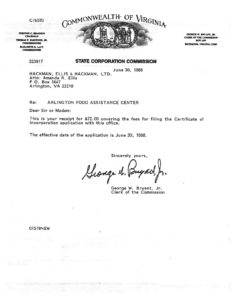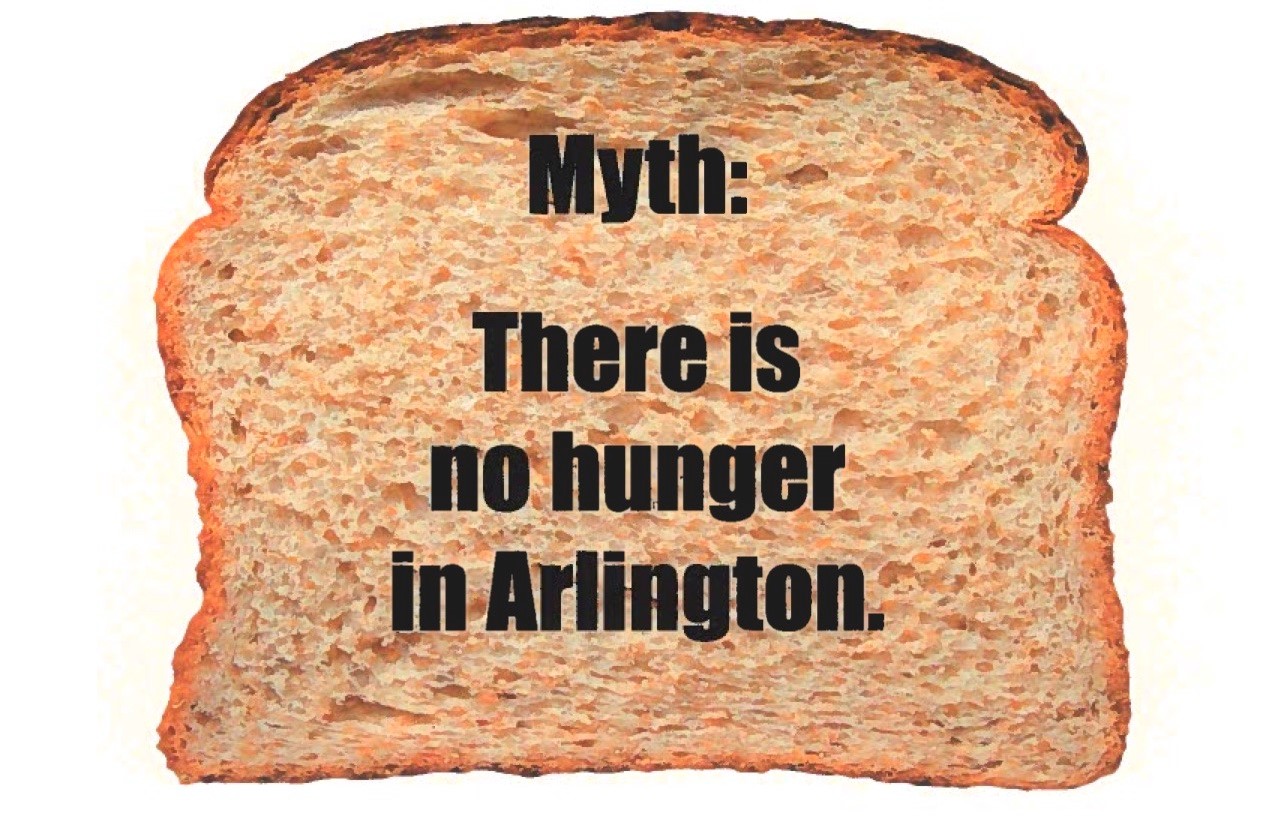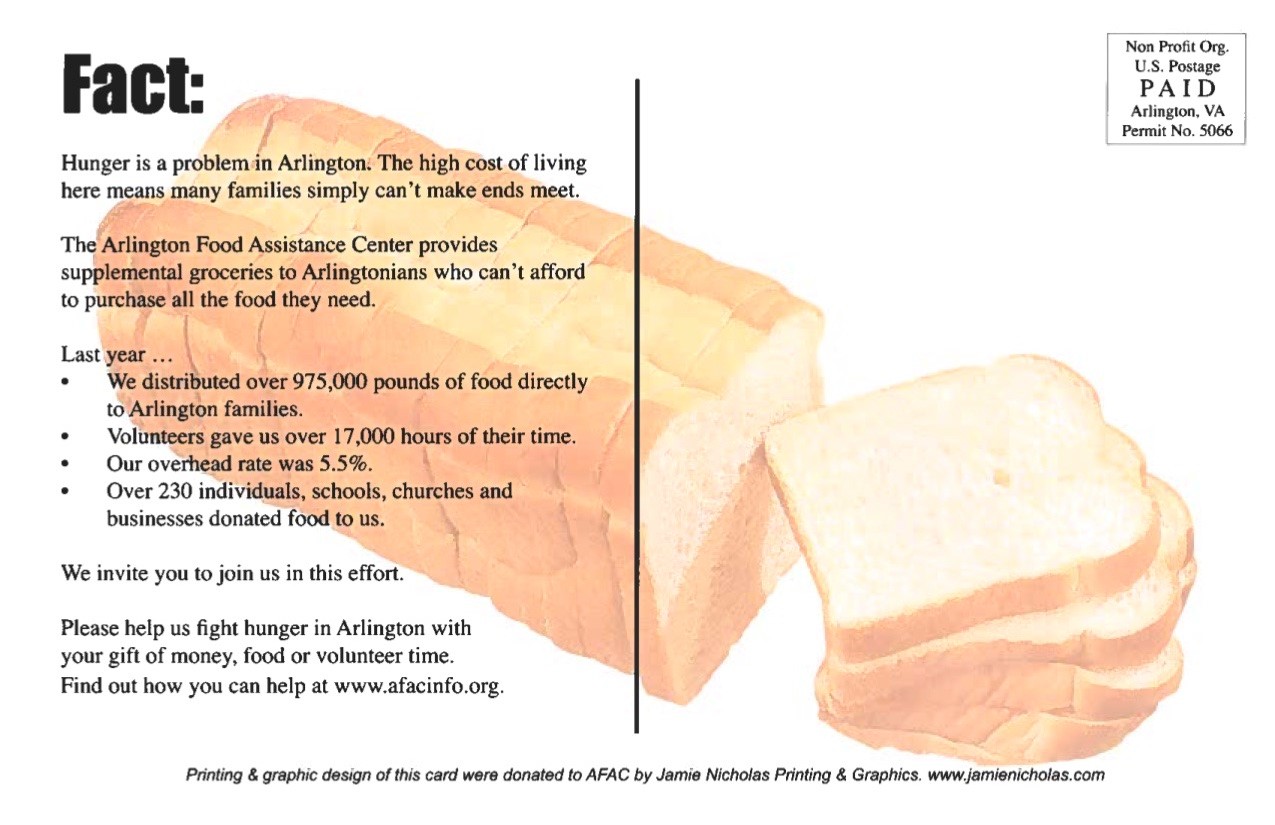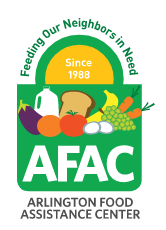Interviews with Ann Rudd and Andy Lee

Oral histories are used to understand historical events, actors, and movements from the point of view of real people’s personal experiences.
The Arlington Food Assistance Center (AFAC) was founded in 1988 under the goal of “obtaining and distributing groceries, directly and free of charge, to people living in Arlington, VA, who cannot afford to purchase enough food to meet their basic needs.” Its formal mission statement as of 2020 is “to feed our neighbors in need by providing dignified access to nutritious supplemental groceries.”
Established by a small public-private committee, the organization began distributing food in a Red Cross van, which was purchased at the Capital Area Community Food Bank in Northeast D.C. The group initially delivered to a small, rotating list of families provided by local churches. Its early founders were Anne Rudd, William Knull, and Anna Barber, who had attended Rock Spring Congregational Church together.
AFAC's Certificate of Incorporation, June 30, 1988.
After over a year of operating out of the van, the First Baptist Church of Clarendon offered AFAC its first fixed operating site, increasing the number of clients the organization could serve. In 1992, AFAC acquired its own full-time operating site at 2900 North Washington Boulevard. The organization moved to its current headquarters at 2708 S. Nelson Street in June 1997 to accommodate its growing operation. More than 30 years after its founding, AFAC now serves more than 3,000 families per month.
In these oral history interviews, founder Anne Rudd and longtime AFAC volunteer Andy Lee describe the early days of AFAC and how the organization grew to become a cornerstone of the Arlington community.
Example of a fundraising effort held by AFAC, advertised in the Washington Post, October 12, 2000. Image courtesy of the Washington Post.
Narrator: Ann Rudd
Interviewer: Michelle Jones
Date: November 20, 2013
Michelle Jones: And how do you really get started? That’s a large—that’s a large job to accomplish.
Ann Rudd: Well I know that they started out—they were using the churches for storage of food.
MJ: Oh.
AR: They were—they used the Baptist church in Clarendon. And they used the Unitarian church and they used Little Falls Presbyterian.
MJ: And what you—
AR: They were sites where people picked up food. Twenty-five years ago was what? Something around three sites.
MJ: So this is around 1988?
AR: Yes. Yeah, so it’s been twenty-five years.
MJ: Okay. So um—Well how did you get—information out to the community?
AR: Well they worked through the county with the Department of Human Services, churches, and community organizations, you had to be referred-you could get food the first time.
MJ: Is that how you received funds? Or how—
AR: No!
MJ: — how did you get started and find a place and—? (speaking at same time)
AR: They did not—they just started calling churches to find a place. As for the money, it was donations. People donated food.
MJ: And what was your involvement in getting all of this going? Were you more on the ground trying to get donations and actual goods or—
AR: I think I was more-or-less contacting churches to see if they would let us set up there. So I think it was those three churches, but it was mainly on the Baptist church when Clarendon was the main place. And it was only open on Saturday morning.
AFAC informational mailer distributed to community members.
Narrator: Andrew “Andy” Lee
Interviewer: Anne Webb
Date: September 30, 2013
Anne Webb: So—what—but you started volunteering when AFAC was still rather small and you’ve seen it grow exponentially. Tell me about your role in all those changes.
Andy Lee: Absolutely. Sure. When I first started volunteering we were serving —serving I think around 70 families per week.
AW: Um-hm (affirmative)
AL: We had one bagging on Friday night and then one distribution on Saturday morning. AFAC was housed in the basement of what was then, Clarendon Baptist Church, and subsequently, as we grew and hired our first staff, we needed office space so Bill Knull at the time, who was president of the board, found a location at 10th and Washington which was at the time we found it, it was being used as a motorcycle repair shop, so it was an absolute mess. … We remained there for several years and then the vision was that we need to expand further as our client load increased and we also need to be closer to our clients. Being in Clarendon the majority of our clients at the time were in Arna Valley, which no longer exists as far as low-income housing but that’s where a lot of our clients were, as well as in the Columbia Pike corridor.
So, we found a location in Shirlington working with real estate agents, Bill Knull primarily, looking at different sites and the current location on South Nelson Street, proved to be for the most part meeting the majority of our needs and so we moved in there I believe in 1996 or 1997 timeframe after some reconstruction of the infrastructure of the building and we’ve been there ever since.
In an addition, we had two primary satellite distribution sites, Clarendon Methodist Church as well as the Gunston Community Center while I was on the board. That has since expanded to multiple different locations, you know we are doing outbound. But at the time South Nelson Street was our primary location as well as the two satellite sites that we had.
As far as the client loads, as I said, when I started, we were about 70 families a week. I think at the peak last year we were around 1,600 families per week on average. I think it’s down now a little bit. But it’s still very high compared to what it used to be.
The AFAC logo as of 2020. Image courtesy of AFAC.
These interviews are available at the Center for Local History. Oral history interviews with Fred Jones, Robert Gallagher, Roberta, and John Overholt, and Ed Nolan also detail the history and work of AFAC.
Want to learn more? Record Group 313 in the Center for Local History also holds documents from and related to AFAC dating from 1948 to 2018
The goal of the Arlington Voices project is to showcase the Center for Local History’s oral history collection in a publicly accessible and shareable way.
The Arlington Public Library began collecting oral histories of long-time residents in the 1970s, and since then the scope of the collection has expanded to capture the diverse voices of Arlington’s community. In 2016, staff members and volunteers recorded many additional hours of interviews, building the collection to 575 catalogued oral histories.
To browse our list of narrators indexed by interview subject, check out our community archive. To read a full transcript of an interview, visit the Center for Local History located at Central Library.




